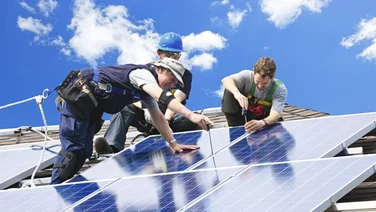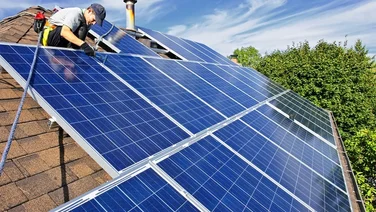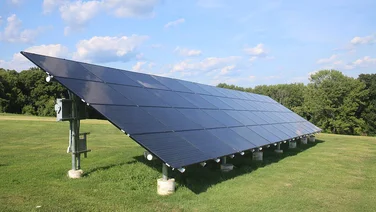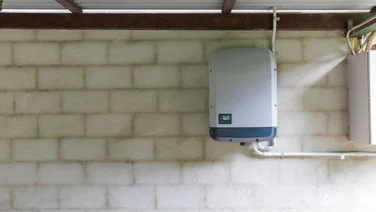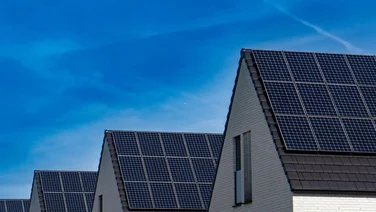- What’s on this page?
- What are integrated solar panels?
- How much do integrated solar panels cost?
- The pros and cons of integrated solar panels
- Advantages of integrated solar panels
- Disadvantages of integrated solar panels
- Can you get integrated solar panels in the UK?
- Should you get integrated solar panels?
- Integrated solar panels vs solar roof tiles
- Integrated solar panel maintenance
- Next steps
- Integrated solar panels are embedded into a tileless section of the roof
- Prices for integrated solar panels range from about £100–£245 per panel
- While more aesthetically pleasing, they’re 3% less efficient than on-roof panels
All types of solar panels have become much less bulky – they’re now designed with aesthetics in mind. Integrated solar panels, in particular, can give users the best of both worlds: high efficiency with a sleek, modern look.
Want to learn more about these discreet panels? We’ve got everything you need to know waiting in our helpful guide below.
If you want to utilise solar energy but would rather stick to regular panels, we’re here to help. You can find the perfect set of solar panels for your home by simply filling out this short form. Once we’ve got some basic information about your property, we’ll connect you with our professional installers, who’ll get in touch with their best prices.
Where do you want to install solar panels?
Get started
What’s on this page?
What are integrated solar panels?
Integrated solar panels – also referred to as in-roof panels – are essentially the same as traditional solar panels, but are embedded into a tileless section of roof.
Unlike regular solar panels (also called ‘on-roof panels’), integrated panels need minimal mounting equipment, and the support that is there is hidden out of sight underneath the panels.
In-roof panels are also designed to behave like roof tiles – they’re weatherproof, waterproof, and can be as strong as normal roof tiles.
Installation is also pretty straightforward. In most instances, you won’t need to alter the underlying roof structure – the roof tiles just need to be removed, and plastic trays are then fitted to the existing structure.
Conventional framed solar panels are then mounted into these trays, and slates are used to fill in any gaps around the trays.
Some roof-integrated solar panels don’t need trays, as they incorporate weatherproof flashing into the frames.
How much do integrated solar panels cost?
You can expect most integrated solar panel systems to cost a similar amount to that of traditional on-roof solar panel systems.
Want to get a better idea of how much this will cost you? Check out the table below to compare solar panel prices for different-sized properties.
|
Property size
|
Annual electricity usage
|
Number of solar panels
|
Average installation cost*
|
Annual electricity bill savings**
|
Time it takes to break even
|
Solar panel profit after 25 years
|
|---|---|---|---|---|---|---|
|
1-2 bedroom house |
3 bedroom house |
4 bedroom house |
||||
|
1,800 kWh |
2,700 kWh |
4,100 kWh |
||||
|
6 |
10 |
14 |
||||
|
£4,216 |
£7,026 |
£9,837 |
||||
|
£272.67 |
£454.45 |
£636.23 |
||||
|
15.46 years |
15.46 years |
15.46 years |
||||
|
£3,026 |
£4,335.11 |
£6,069.16 |
* Please note these prices are based on Microgeneration Certification Scheme (MCS) cost data (March 2023), the average price of electricity (October-December 2023), and Ofgem’s latest typical domestic consumption values (2023). Total costs may increase with more complex installations. The above estimates do not include the cost of a solar battery.When it comes to installing an integrated solar panel system, there are two ways you can go about it:
- Use standard panels – This involves mounting regular panels on an in-roof frame, such as the GSE system or EasyRoof Evolution. This will cost a similar amount to the prices in the table above
- Use a bespoke system – This involves having the panels made specifically for the property, and will therefore cost more than having standard panels installed. This service is currently provided by Viridian, SolFit, or GB-Sol
Unlike regular solar panel installation, you’ll also need to take the roof retrofitting into account, which involves removing and installing the slates/tiles. The price tag on roof retrofitting will vary widely, depending on the size of the roof and the material it’s made of.
Other factors that can alter the price of integrated solar panels include:
- The number of panels you have
- Whether you’re adding them to a new build or retrofit
- How much energy you need the panels to generate
- Which manufacturer you choose
The pros and cons of integrated solar panels
Before you invest in a set of integrated solar panels, you should outweigh the advantages and disadvantages – they might not be for everyone.
To give you a head start, we’ve listed some of the pros and cons below.
- Aesthetically pleasing
- Affordable
- Lightweight
- Good for homes with restricted planning permission
- Low maintenance
- No interference from pigeons
- Lower efficiency
- Retrofitting can be difficult
Advantages of integrated solar panels
Anyone keen on getting themselves an integrated solar panel system will be pleased to know that the pros significantly outweigh the cons. Check out some of the advantages of integrated solar below.
Aesthetically pleasing
In 2021, we carried out a survey on the appearance of solar panels. Overall, we found that half of respondents aged 13-40 think solar panels are attractive, which drops to just 11% amongst 57-72 year olds. As for 73-88 year olds? Zero respondents in this bracket find solar panels attractive.
If you agree with the older generations in our study that traditional solar panels are unattractive, integrated panels might be for you. Since they’re installed as part of a roof’s structure, integrated solar panels sit snugly with the roof tiles and blend in more seamlessly.
It’s a great look for any style of house.
Affordable
Although they were once much more expensive than on-roof panels, integrated solar panels are now pretty affordable – great news, since 69% of people ranked cost as the most important factor when evaluating which low-carbon product to purchase. And, according to our survey, 43% of them said high energy bills prevent them from buying green tech.
As the technology has become popular, more manufacturers have started offering integrated solutions, and the panels have become more affordable to meet demand. In fact, you can now expect in-roof panels to cost a similar amount to regular panels.
Lightweight
Standard solar panels can be too heavy for some roofs, which can cause maintenance issues with both the building and the panels.
However, since roof-integrated systems aren’t placed on top of tiles, but replace them, they’ll add little additional weight – if any – to your roof.
Good for homes with restricted planning permission
Since integrated panels are designed to sit flat with the roof – and can often be altered to match a certain colour scheme – they’re more likely to qualify for planning permission in listed buildings or protected areas.
Plus, in-roof solar panels won’t add extra weight to the roof, which is another bonus for older, more delicate buildings.
Low maintenance
Solar panels are already pretty low-maintenance pieces of kit, but in-roof panels go one step further.
Since integrated solar panels are embedded into the roof, they don’t have a mounting frame, which means there’s no room for birds to nest underneath.
That’s right, you probably won’t have to worry about having to pigeon-proof your solar panels! The lack of visible framing also means there’s nowhere for debris to build up.
No interference from pigeons
Unlike regular on-roof panels, integrated solar panels don’t have a gap between the unit and the roof.
Pigeons tend to utilise this space as shelter, making themselves pretty at home. But what’s the harm in having a few pigeons huddled under your solar panels? Well, they can cause damage to the panels, which will result in reduced output and lower savings on your bills.
Thankfully, integrated-solar-panel owners won’t have to deal with this problem.
Where do you want to install solar panels?
Get started
Disadvantages of integrated solar panels
Like pretty much any bit of tech, there are some downsides to integrated solar panels. Check them out below.
Lower efficiency
Clearly, integrated solar panels have a lot of benefits, but one key disadvantage is that they’re usually 3% less efficient than on-roof solar panels.
This is because, unlike on-roof solar panels, integrated panels sit snugly in the roof rather than mounted on brackets. This means that there’s less air ventilation around the panel to help keep it cool.
On very hot days, this lack of ventilation can lead your solar panels to overheat and generate less energy.
What does this mean for homeowners? Lower solar panel efficiency ultimately means less solar-generated electricity, so the payback period will be a bit longer than regular solar panels.
Retrofitting can be difficult
You can add integrated solar panels to a pre-existing roof – but it comes with some difficulties you won’t encounter when installing solar panels on a new build.
It’ll usually cost more and take longer because the installer will need to remove the roof’s tiles or slates, and generally because of the greater complexity level.
Can you get integrated solar panels in the UK?
Yes, you can! More manufacturers have been selling integrated panels widely across the country – and there are plenty of UK-based companies to choose from, including:
- GB Sol – This Wales-based solar manufacturer has 20 years of expertise and an award-winning roof-integrated system. Although it’s one of the most popular suppliers, GB Sol offers bespoke options, which can be more expensive
- GSE Integration – Although GSE supplies panels in the UK, its in-roof system also dominates over 60% of the market share of residential solar installations in France. Plus, the materials used are 100% recyclable! As if you needed another reason to like this product, it’s also on the cheaper end of the price spectrum
- Viridian – This Cambridge-based company’s system, named Clearline Fusion, has five different panel ‘kits’ which are suitable for different roof styles. These panels don’t rely on a plastic tray, and instead have an innovative frame that locks between panels to achieve a weathertight finish
| Manufacturer | Product | Performance warranty | Manufacturer warranty |
|---|---|---|---|
GB Sol | Roof-Integrated System | 25 years | 10 years |
GSE Integration | In-roof Integration | 10 years | 10 years |
Viridian | Clearline Fusion | 25 years | 10 years |
Should you get integrated solar panels?
Although more than two thirds of Brits would now buy a property with solar panels on the roof, some people still aren’t a fan of the way they look.
If you come under this bracket, but you’d like to benefit from the cheap, green electricity they produce, then integrated solar panels might be the right option for you.
Their sleek aesthetics are the main selling people for homeowners, but you’ll also benefit from a much smaller carbon footprint.
But are integrated solar panels worth it financially? That depends on the state of your roof.
If you’re replacing your roof before installing a set of integrated solar panels, then it’s the perfect time to invest. However, if you’ll need to remove a section of tiles just to install the panels, it probably isn’t worth it – the added cost of removing the tiles/slates will outweigh the cost savings from the panels themselves.

Integrated solar panels vs solar roof tiles
Although they have the same goal – to generate solar power whilst looking aesthetically pleasing – integrated panels and solar roof tiles are very different.
Integrated solar panels sit in the roof covering, but are often the same size as conventional framed solar panels – meaning they’re still visible – while solar tiles are usually the same shape and colour as the tiles they are replacing.
Solar roof tiles are also much more discreet than integrated panels – sometimes it can even be hard to tell if they’re solar tiles or normal tiles if you’re standing from a distance.
Although solar tiles can be much better for some homeowners, it’s also important to note that they’re less efficient than panels – which means they won’t be able to generate as much energy as integrated panels.
Integrated solar panel maintenance
Good news – integrated solar panels are even more low maintenance than their on-roof counterparts.
Solar panels have no moving parts, which makes them relatively low maintenance, but integrated systems have even fewer parts to keep in good condition. As we mentioned earlier, you probably won’t have to worry about pigeon-proofing your panels, or checking debris as often, thanks to the lack of brackets.
Aside from this, integrated panel maintenance is pretty much the same as regular on-roof panel maintenance. Want to keep your panels in tip-top shape? Here are six key things you should do to look after them:
- Get your panels serviced every 5-10 years
- Clean your solar panels once every five years
- Remove potential dangers regularly
- Keep solar panels out of the shade
- Make sure the inverters are flashing green
- Check day-to-day performance
Want to learn more about how to look after your solar panels – whether integrated or on-roof? Check out our helpful guide on solar panel repair and maintenance.
Next steps
The solar panel industry is always evolving, with its ongoing efforts to increase domestic panels’ efficiency, make panels look more aesthetically pleasing, and find new ways to generate more electricity.
Despite this, traditional solar panels are typically the most popular option to go with, which usually comes down to their price and efficiency.
If you think your home could benefit from a set of panels, you’ve come to the right place. We can help you find the best deal with our easy-to-use quote tool.
All you have to do is pop your details in this short form, and our suppliers will get in touch with their best solar panel prices.


